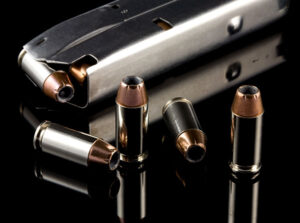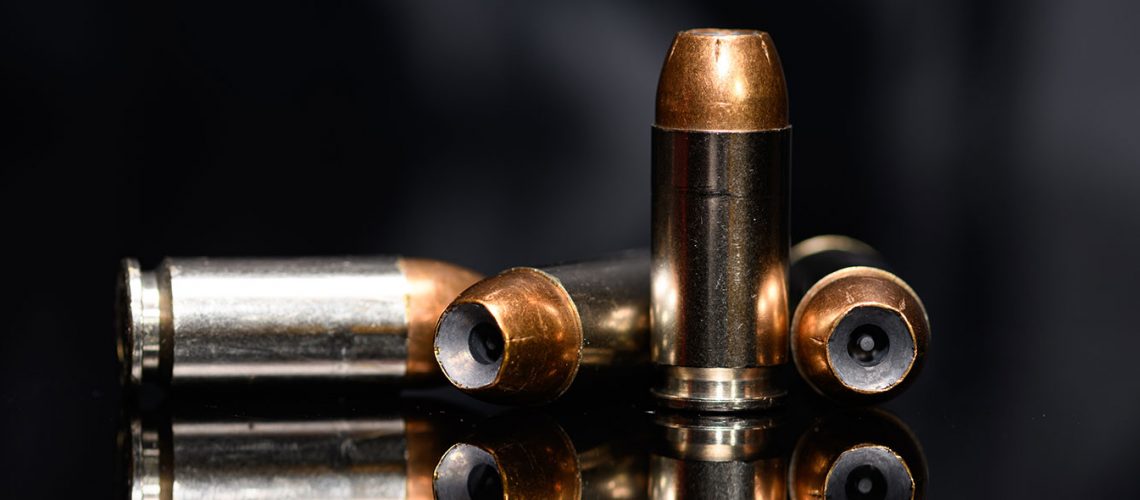Created to provide the FBI a round that could compete with the escalated firepower of criminals, the .40 Smith & Wesson cartridge has a relatively short, but interesting, history.
 BORN FROM AN FBI TRAGEDY
BORN FROM AN FBI TRAGEDY
In April of 1986, a small team of FBI agents closed in on two criminals suspected of a violent crime spree in the Miami area.
When agents approached the suspects, a gun battle resulted in which the lives of two agents were lost. Both suspects also died, but only after suffering numerous gunshot wounds. As a result, the FBI realized that their standard issue .38 and 9mm ammunitions were ineffective and demanded a more powerful replacement.
The FBI first investigated the 9mm and .45 Auto rounds, intending to use a semi-automatic pistol to replace their standard-issue revolver. While testing those two rounds, John Hall (the FBI Firearms Training Unit’s special agent-in-charge) included his own 10mm personally loaded ammo. The testing revealed that Hall’s 10mm rounds delivered the required performance without the heavy recoil commonly associated with the 10mm round.
With these results in mind, the FBI reached out to Smith & Wesson, requesting a 10mm round that would function within the Smith & Wesson Model 4506, a .45 Auto handgun.

 While developing the desired round, S&W realized that the round the FBI requested would need to be downsized—resulting in less power. The smaller powder charge of this specialty load didn’t take full advantage of the 10mm case capacity. Reducing the length of the case was a natural solution to save some space, while still delivering on the FBI’s requested parameters for ballistic performance.
While developing the desired round, S&W realized that the round the FBI requested would need to be downsized—resulting in less power. The smaller powder charge of this specialty load didn’t take full advantage of the 10mm case capacity. Reducing the length of the case was a natural solution to save some space, while still delivering on the FBI’s requested parameters for ballistic performance.
That’s when S&W teamed up with Winchester to produce a brand new cartridge—the .40 S&W.
THE .40 S&W CARTRIDGE DEBUTS
The new cartridge launched on January 17, 1990, in tandem with the announcement of a new S&W pistol for the .40 SW, the Model 4006. However, it would be several months before the Model 4006 would be available—and the delay would have significant consequences.
Glock released two pistols (Glock 22 and Glock 23) chambered with the .40 S&W a week before the S&W announcement of the Model 4006, and those pistols were an immediate success. In fact, the FBI adopted the two Glocks for standard issue in May of 1997.
 Popularity of the .40 S&W round also gained traction with the passage of the Federal Assault Weapons ban of 1994. Because magazines of over 10 rounds were banned as being “high capacity”, motivating many firearm buyers to opt for the more powerful and larger diameter .40 S&W round over smaller cartridges.
Popularity of the .40 S&W round also gained traction with the passage of the Federal Assault Weapons ban of 1994. Because magazines of over 10 rounds were banned as being “high capacity”, motivating many firearm buyers to opt for the more powerful and larger diameter .40 S&W round over smaller cartridges.
PERFORMANCE
The .40 S&W features nearly the same accuracy attributes of a 9mm round, with less recoil than a 10mm Auto cartridge.
The .40 S&W also has many of the same characteristics of the Winchester .38-40. These rounds are both 10mm (.400 in.) and use the same weight range of bullets (typically 155-180 grains), with similar muzzle velocities.

 DISADVANTAGES
DISADVANTAGES
Case failure is a characteristic drawback associated with the .40 S&W round. The high working pressure of the round has been known to cause case failure in older Glock models, due to the large amount of unsupported case head in their barrels.
In older Glock .40 S&W models, the feed ramp is larger than on other Glocks—creating an unsupported rear bottom of the case, causing case failures. Almost all of the failures have occurred with reloaded or remanufactured ammunition, and rounds loaded at or above recommended pressure are often believed to be the culprit.
Injuries are rare in case failures. However, the high-pressure gas which is vented in the failure frequently ejects the magazine out of the well, and can destroy the pistol. Occasionally, the barrel will also fail.
RETAIL
In modern retail, the number one disadvantage of the .40 S&W round is availability. Many retailers lost motivation to keep .40 S&W in regular inventory when it was drastically outsold by 9mm and .45 ACP. Manufacturing constraints exaggerated this further in the 2020 ammo run, when many large ammunition factories decreased or stopped production of the .40 S&W to change out tooling to produce more 9mm rounds—which were in high demand.
The FBI has since returned to the 9mm, and the 10mm is returning in popularity. However, for its relatively short moment as the first choice in ammunition on the part of owners, and law enforcement, the .40 S&W holds a special place in the history of cartridges.

